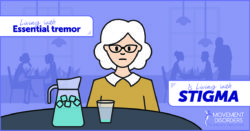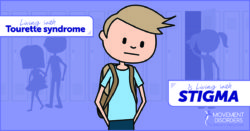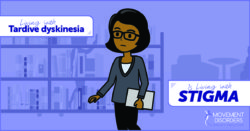Living with Stigma
March 16, 2018
Living with a movement disorder means living with stigma.
Stares, whispers and pointing are just another part of the disease burden for the millions of Americans with Tourette, essential tremor, tardive dyskinesia, Huntington’s disease or other movement disorders. The stigma can have wide-range effects on a patients’ quality of life.
Tammy Dodderidge of the International Essential Tremor Foundation conveyed several patients’ experiences. “One woman described the questions she gets from her children: Why is she shaking, why grandma shakes too, or the most difficult question, the child asking ‘Will I shake like that when I grow up?’”
Another patient explained, “I have worked with the public all of my life, and you will always have people who comment on it. Most people have never heard of essential tremor …and are apologetic when they finally understand.”
Patients with Tourette syndrome face public misconceptions as well. People often associate the disease with outbursts of obscenities or socially inappropriate remarks, though only about 10 percent of Tourette’s patients exhibit these behaviors. More commonly, Tourette syndrome is characterized by tics – repetitive, involuntary sounds or movements. Inviting further stigma, Tourette’s patients often experience other neuropsychiatric conditions such as obsessive-compulsive disorder or attention-deficit/ hyperactivity disorder.
Not all movement disorders patients have the opportunity to explain their condition – or want to. Some dodge awkward situations altogether by avoiding restaurants, shops and public venues. Yet social isolation can worsen the mental health challenges that many movement disorders patients already face.
Given the impact of stigma, what is the value of alleviating it?
The issue came to the forefront last year when the Institute for Clinical and Economic Review failed to account for stigma in its review of a new treatment for tardive dyskinesia. Instead, ICER simply determined that the drugs, called “VMAT2 inhibitors,” were too expensive.
“It is unfortunate that the ICER review is likely to provide payors—both public and private—with the ammunition needed to restrict access to these promising and long overdue therapies to treat TD,” noted Andrew Sperling of the National Alliance on Mental Illness.
For those with tardive dyskinesia, involuntary movements such as frowning, tongue thrusting or lip smacking can lead to social isolation. These motions can also lead to difficulty fully participating in one’s community or maintaining a job.
Ignoring one of the primary benefits of the new treatment—that it can limit uncontrollable movements and in turn, intense social stigma—is a setback for movement disorder patients.
“For patients that have been living with moderate to severe TD for years, the opportunity to finally have an innovative therapy that can allow for employment and social integration is a game changer,” Sperling added.
The movement disorders community remains hopeful about new therapies to address symptoms and alleviate stigma – and for policies that allow patients to access those therapies.
To learn more, read “Movement Disorders: Impact and Access to Treatment” from the Movement Disorders Policy Coalition.
Tags: Cost Value, NeurologicalCategorized in: Blog




